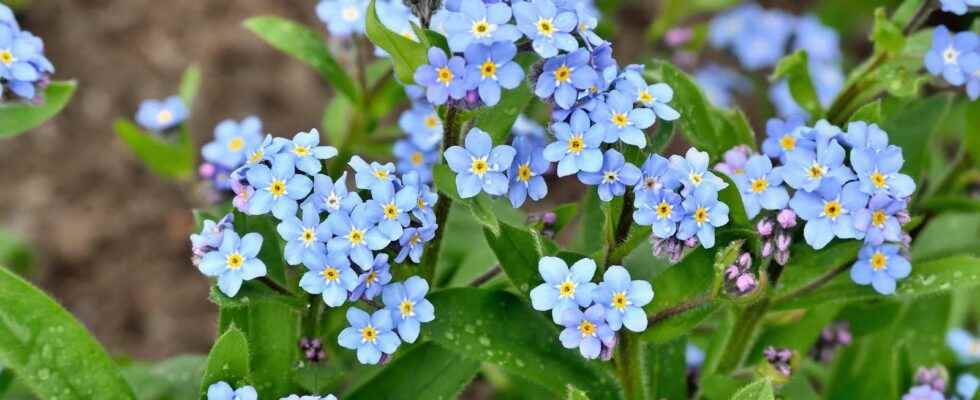From spring, admire the forget-me-not with small delicate flowers of color blue, pink or white that line the beds. Easy to grow and resistant, take advantage of the ease of forget-me-nots to resow themselves to compose magnificent colorful carpets.
Appellation
The forget-me-not (forget-me-not) is a herbaceous plant that can be annual, biennial or perennial and which is part of the Boraginaceae family (Boraginaceae).
Botanical description of the forget-me-not
The forget-me-not forms low clumps about 30 cm high with hairy stems that are covered with small flowers at eye yellow. Mainly blue in colour, there are also forget-me-nots with white or pink flowers.
There are several species of forget-me-nots:
- forget-me-nots wood or forests (Myosotis sylvatica): biennial plant that appreciates the cool soils of the undergrowth and offers exceptional flowering from April to June;
- Alpine forget-me-not (Myosotis alpestris): a perennial plant grown as a biennial that flowers from May to August;
- field forget-me-not (Myosotis arvensis): biennial or annual plant that flowers from May until the first days of autumn;
- marsh or aquatic forget-me-not (Myosotis scorpiodes Where palustris): perennial plant that flowers from May to September;
- Caucasian forget-me-not (Brunnera macrophylla): hardy perennial that is covered with small flowers from April to May. This species is as much sought after for the many decorative foliage of its varieties as the color of its small, very vaporous flowers.
Origins of the forget-me-not
It is known to have European origins in vast wilderness areas.
Cultural requirements of the forget-me-not
the Sun as well as partial shade are suitable for forget-me-nots to bloom from March to June. Install it in a Earth classic, drained and fresh in summer. Sow them in the shelter after the Ice Saints (Saint Mamert, Saint Pancrace and Saint Servais), around mid-May or in the ground, in July-August for flowering the following year. The young plants will be transplanted the following spring, directly to their final location. If you buy pots, you can plant them in fall or in the spring, spacing them 25 cm apart.
If the forget-me-not becomes overgrown, pull it out, divide it in the spring, or transplant it. In pots or balconies, water more often than the forget-me-not grown in beds.
After enjoying flowering, cut the clump at ground level unless you want to make a spontaneous sowing. Hardy down to -20°C and even -30°C for some species, the forget-me-not will pass thewinter outside, without protection except for the subjects in pots, in the currents ofair where a winter veil will be welcome.
Use of forget-me-not
The forget-me-not does just as well in a pot, a planter as in a flowerbed or a rockery. In the spring, compose pots of tulips or of thoughts in the center with forget-me-nots all around. Mix white, pink and blue flowers in a bed of undergrowth or a bed of spring bulbs (tulips, fritillaries, narcissus). Pick a few stems to compose small bouquets with primroses or ornamental apple blossoms.
Form borders to delimit squares of vegetable garden and thus offer pollinating insects, sweet nectar from the first days of spring. The forget-me-not is really the plant for all situations in the garden, in the balcony or on the Terrace. Take advantage of its flowering which lasts from March to the first days of summer.
You will also be interested
[EN VIDÉO] Spring: where to admire the most beautiful fields of flowers? When spring comes, the fields turn into a sea of flamboyantly colored flowers. In some regions, expanses of tulips, lavender or lilies stretch as far as the eye can see. Here are the best places to enjoy it and take the most beautiful photos.
Interested in what you just read?
